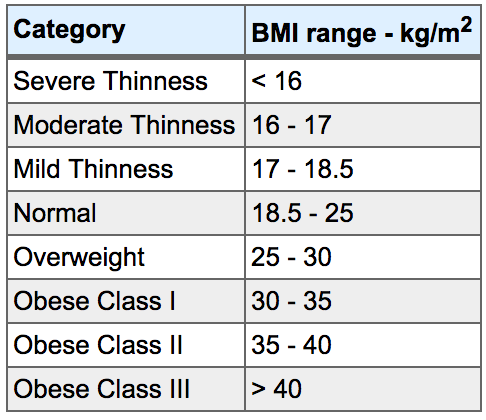What is the BMI Calculator?

What is the BMI Calculator? Body mass index or BMI is a measure of body fat based on height and weight that applies to adult men and women. Your BMI is a number derived from your weight (mass) and height and once you calculate your BMI number you can cross-reference your BMI number with the BMI chart and find out if you are underweight, healthy weight, overweight or obese.
BMI calculator
How do I calculate BMI? The BMI calculator below uses both imperial and metric units. The original BMI equation was developed in metric units and looks like this BMI Formula Metric Units = weight (kg) / [height (m)]2. In imperial units, the BMI equation looks a little bit different and there are a few different ways to calculate your BMI using imperial units. Here is one of the calculations used to calculate BMI in pounds. Imperial BMI = weight in lb * 703 / [height (in inches)]2. To simplify your BMI calculation you can plug in your number in the BMI calculator below. Please note that the BMI calculator below was pulled from this bmi widget. You can plug in your numbers below:
What is a good Body Mass Index
A good body mass index is different from adults and for children. The below chart is the world health organization recommend body weight based on BMI values for adults. The BMI numbers are used for both men and women that are age 18 or older. To find your health status reference the BMI Chart below:

BMI Chart
Normal BMI Measurements
BMI is a standardized way to measure your health. However, your BMI calculator can’t distinguish between fat and muscle. When you put your body weight the BMI calculator does not know if your body weight is fat, or if your body weight is muscle. Muscle tends to be heavier and can tip more toned individuals to overweight status, even if the fat levels are low. Also, your BMI calculator does not take into account your bone density and water weight. Alternatives to the BMI equation that take into account the leanness or corpulence of a person is the ponderal index, also known as the PI Equation. BMI calculations will overestimate the amount of body fat for body builders, pregnant women, some high-performance athletes. By contrast, BMI calculations will underestimate the amount of body fat for the elderly, and for people with a physical disability, who are unable to walk and may have muscle wasting. Overall, to find another accurate measurement of weight and health risk, a person’s waist circumference can be used in addition to the BMI calculation as a predictor of health risk.
Understanding Your BMI for Men
If your BMI is between 18.5-24.9, your BMI is considered normal. If your BMI is above 30, your BMI is considered overweight. If your BMI is below 18.5: Your BMI is considered underweight. Keep in mind that an underweight BMI calculation may pose certain health risks. According to the BMI Formula, an adult male who is 5’8” should weigh between 130 and 165 pounds.
Understanding Your BMI for Women
Current guidelines from the Centers for Disease Control and Prevention, and the World Health Organization define a normal female BMI range as 18.5 to 24.9. To have a BMI under 18.5, for a female is considered very underweight and possibly malnourished. Furthermore, a BMI between 25.0 and 29.9 is classed as overweight. Finally, a BMI over 30 is considered obese.
BMI and Body Fat Score for Adults
Men who are between 20-40 years old with under 8% body fat are considered “underfat”, whereas a “healthy” range is described as between 8-19%. For women in this same age group, any level under 21% is “underfat” and 21-33% is considered “healthy”.
Children’s BMI Calculation
In children and teens, BMI is used to find out if a child or teen is underweight, of a healthy weight, overweight, or obese. A child’s body fat changes with age. Also, girls and boys differ in their amount of body fat as they mature. This is why BMI for children, also known as BMI-for-age, includes gender and age. As children grow, their amount of body fat changes and so will their BMI. Since children are constantly growing. For example, BMI usually decreases during the preschool years and then increases into adulthood
Kids who measure at the 85th to 94th percentiles are considered overweight, because of excess body fat or high lean body mass. A child whose BMI is between the 5th percentile to 85th percentile is in the healthy weight range. A child with a BMI below the 5th percentile is considered underweight.
BMI Related Diseases for High BMI
If you are overweight (with a BMI over 25) and physically inactive, you may develop cardiovascular disease (heart and blood circulation problems), gallbladder disease, high blood pressure (hypertension), type 2 diabetes, osteoarthritis, some types of cancer like colon and breast cancer, depression and other mental illnesses. All of these are the result of an unhealthy BMI.
BMI Related Diseases for Low BMI
Low BMI can also cause health-related problems. If you are underweight (BMI less than 18.5), you may be malnourished and develop compromised immune function, respiratory disease, digestive disease, cancer, osteoporosis.